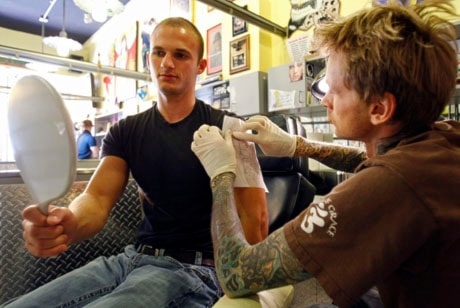One of the stranger moments in recent tattoo history occurred when rock star Ozzy Osbourne turned to the TV camera during his short-lived reality show and urged teens to skip the ink.
The problem, said the man with O-Z-Z-Y spelled out on his knuckles, is that tats, once subversive, are now ubiquitous and mainstream.
“Kids, if you want to be special,” he said, “don’t get a tattoo.”
Fat chance. A Pew study released last month that looked at millennials (people in their teens and 20s) found that nearly 4 in 10 have at least one tattoo, with half of them sporting anywhere from two to five tattoos and 18 percent having six or more.
With TV’s “Miami Ink” bringing tattoos into Americans’ living rooms, actresses such as Angelina Jolie sporting tattoos on their limbs and high-fashion lines like Rodarte giving runway models temporary tattoos for the catwalk, tattoos have definitely gone high-profile.
Here are the thoughts of three well-known San Francisco tattoo artists about trends and factors to consider before going under the needle.
Jeff Rassier of Black Heart Tattoo, widely regarded as one of the city’s best, said TV has made tattoos so mainstream that more people are asking for bigger tattoos than ever, but with unrealistic expectations.
“People see it happen in one TV episode,” said Rassier, a two-decade industry veteran. “To get your entire arm tattooed takes 20 to 30 hours over the course of a year.”
Memorial tattoos -- a symbol, word or portrait to commemorate a loss or a death -- are in vogue, he said. Tattooed quotations or poems are also popular, along with religious tattoos, such as Hindu and Buddhist deities, and even floral tattoos that help mastectomy patients hide their scars.
Customers are also generally more informed than in the past because they have researched procedures and styles on the Internet, said Tanja Nixx of Lyle Tuttle Tattooing. That shop, and Tattoo City, founded by Don Ed Hardy, are among the most famous in the nation for their pioneering work in the 1960s and ’70s in expanding the pictorial possibilities in body art. Tuttle worked with the city’s Department of Public Health to develop standardized practices for equipment sterilization.
“People used to walk in off the street, asking for stars and butterflies, but now they look at the photo galleries of artists’ work online, trying to find styles they like and colors they like,” said Nixx, a graphic artist who has been tattooing for 15 years.
“I’ve actually had more women in the 40s, 50s and 60s come in than in years past, typically women attending conventions in town.”
One disadvantage of the Internet, said Shannon Archuleta, an artist known for her Art Nouveau and floral designs, is the proliferation of how-to tattoo videos. Some contain unsafe practices such as the artist failing to wear latex gloves while tattooing (blood is wiped off the skin during needlework) and the use of underarm deodorant, rather than surgical scrub soap, as an agent to transfer a stencil to the skin.
Archuleta, with 16 years of tattooing under her belt, said she has recently seen more 18-year-olds coming in asking for tattoos on their necks. Sometimes she turns them down.
“They’re going to be bummed when they realize what they can’t do with their lives because of how they look,” she said. “I mean, do you really want to work in a coffee shop your whole life?”
Carolyne Zinko writes for the San Francisco Chronicle.
